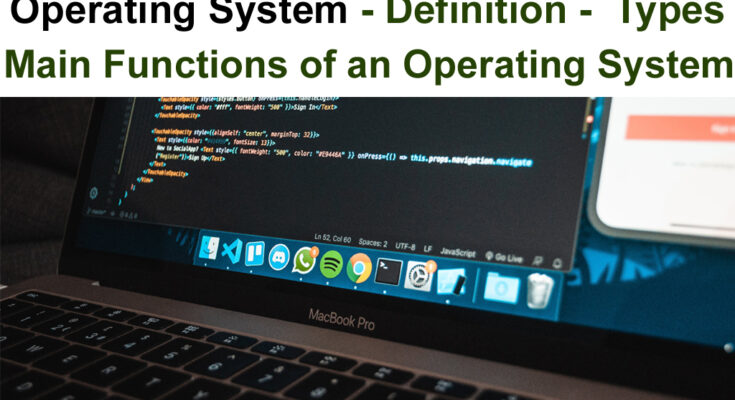What is Operation System (Definition)
An operating system, commonly abbreviated as OS, is a fundamental software component that acts as an intermediary between computer hardware and user applications. It serves as the foundation for managing and coordinating various resources, providing an environment in which users can interact with the computer system.
The primary purpose of an operating system is to facilitate the execution of diverse tasks and applications on a computer by overseeing hardware resources such as the central processing unit (CPU), memory, storage, and input/output devices. It provides a user interface, which can range from command-line interfaces to graphical user interfaces, enabling users to interact with the computer system and run applications.
Operating systems play a crucial role in optimizing resource utilization, ensuring efficient task scheduling, managing memory, handling file systems, and providing essential services for application development and execution. Additionally, they contribute to system security by implementing access controls, user authentication, and other protective measures.
In essence, an operating system serves as the underlying infrastructure that enables the functionality and usability of computers, allowing users to perform a wide range of tasks while abstracting the complexities of hardware management.
Introduction of Operating System in Computer
In the intricate world of computing, the operating system (OS) stands as a foundational cornerstone, orchestrating the harmonious collaboration between hardware and software components within a computer. Essentially, an operating system is a crucial software entity that serves as a mediator, enabling users and applications to interact seamlessly with the underlying computer hardware.
At its core, the operating system is the master conductor, managing and allocating resources such as the central processing unit (CPU), memory, storage, and peripheral devices. It provides a user-friendly interface through which individuals can navigate and command the computer, whether through traditional command-line interfaces or modern graphical user interfaces.
The significance of an operating system lies in its ability to facilitate the execution of diverse applications, ensuring they run efficiently and cohesively. It acts as a bridge, translating user commands into machine-level instructions that the hardware can understand and execute. Without an operating system, the interaction between users and computers would be a complex and arduous task.
Moreover, operating systems contribute to the overall stability, security, and reliability of a computer system. They manage processes, allocate memory, handle input and output operations, and safeguard against potential security threats. In essence, the operating system is the unsung hero, working tirelessly in the background to ensure the smooth operation of the computer and the seamless execution of myriad tasks.
As we embark on this exploration of operating systems, we will delve into their historical evolution, various types, functions, and their pivotal role in the ever-evolving landscape of computing. Join us on this journey to unravel the intricate layers of the operating system and gain a deeper understanding of its indispensable role in the realm of computer technology.
Types of Operating Systems
Single-User Operating Systems
Designed for individual use, single-user operating systems like Microsoft Windows and macOS provide a personalized computing experience. They excel in simplicity and ease of use, making them ideal for everyday tasks.
Multi-User Operating Systems
In contrast, multi-user operating systems facilitate concurrent usage by multiple users. Commonly found in enterprise environments, examples include UNIX and Linux, supporting a multitude of users simultaneously.
Real-Time Operating Systems
Industries demanding instantaneous responses, such as aviation and healthcare, rely on real-time operating systems. These systems prioritize timely execution of tasks, ensuring critical processes transpire without delay.
Functions of an Operating System
Process Management
An OS oversees the execution of processes, managing resources to ensure efficient task completion. Process scheduling and coordination are integral aspects of this function.
Memory Management
Efficient utilization of memory is paramount for optimal system performance. Memory management in an OS involves allocation, deallocation, and optimization to prevent bottlenecks.
File System Management
Operating systems organize and manage files through a file system. This function involves file creation, storage, retrieval, and maintenance.
User Interface
The user interface is the gateway for human-computer interaction. Operating systems offer diverse interfaces, from command-line interfaces to intuitive graphical user interfaces.
Popular Operating Systems
Windows
Microsoft’s Windows OS dominates the desktop computing landscape, known for its user-friendly interface and extensive software compatibility.
macOS
Apple’s macOS, synonymous with sleek design and seamless integration, powers Mac computers, providing a cohesive user experience.
Linux
Linux, an open-source operating system, is celebrated for its stability and versatility. It powers a myriad of systems, from servers to embedded devices.
Challenges in Operating System Design
Security Concerns
As technology advances, the threat landscape expands. Operating systems grapple with the challenge of fortifying themselves against evolving cyber threats, requiring robust security measures.
Compatibility Issues
Interoperability between diverse hardware and software components poses a perpetual challenge. OS developers must navigate compatibility hurdles to ensure seamless user experiences.
User Interface Design Challenges
Creating an intuitive and user-friendly interface is an ongoing challenge. OS designers strive to balance aesthetics with functionality, catering to diverse user preferences.
Future Trends
Advances in Artificial Intelligence Integration
The integration of artificial intelligence within operating systems is an unfolding trend. AI-driven features enhance user experiences, from predictive typing to intelligent virtual assistants.
Cloud Computing and Operating Systems
Cloud computing is reshaping the landscape, and operating systems are evolving to seamlessly integrate with cloud services. This shift enables users to access and manage data from anywhere.
Internet of Things (IoT) Impact
The proliferation of IoT devices necessitates operating systems capable of managing and coordinating a vast network of interconnected devices, from smart home appliances to industrial sensors.
Importance in Computing
Facilitating Software Applications
Operating systems provide a platform for software applications to run efficiently. They act as intermediaries, ensuring compatibility and resource allocation for diverse applications.
Enhancing Hardware Utilization
Efficient utilization of hardware resources is a hallmark of a well-designed operating system. Through intelligent resource management, an OS maximizes the potential of underlying hardware.
Providing a User-Friendly Experience
Perhaps most importantly, operating systems serve as the bridge between technology and users. A well-crafted OS offers a seamless and user-friendly experience, fostering widespread technology adoption.
Conclusion
In the dynamic landscape of computing, the operating system remains an indispensable force, evolving alongside technological advancements. From humble beginnings to the integration of cutting-edge technologies, operating systems continue to shape the digital experience. As we traverse the future, the role of operating systems in facilitating innovation and connectivity is bound to become even more pronounced.
FAQs
What is the primary function of an operating system?
The primary function of an operating system is to manage and coordinate hardware and software resources, facilitating efficient execution of processes and providing a user interface.
Which operating system is known for its open-source nature?
Linux is renowned for being an open-source operating system, allowing users to access and modify its source code.
How do real-time operating systems differ from others?
Real-time operating systems prioritize timely execution of tasks, making them suitable for applications where instantaneous responses are crucial, such as in aviation or healthcare.
Why is security a significant challenge for operating systems?
As technology advances, cyber threats evolve. Ensuring the security of an operating system is challenging due to the constantly changing threat landscape.
What role does the user interface play in operating systems?
The user interface is the point of interaction between users and the computer. Operating systems provide diverse interfaces, catering to user preferences and facilitating seamless interaction.




